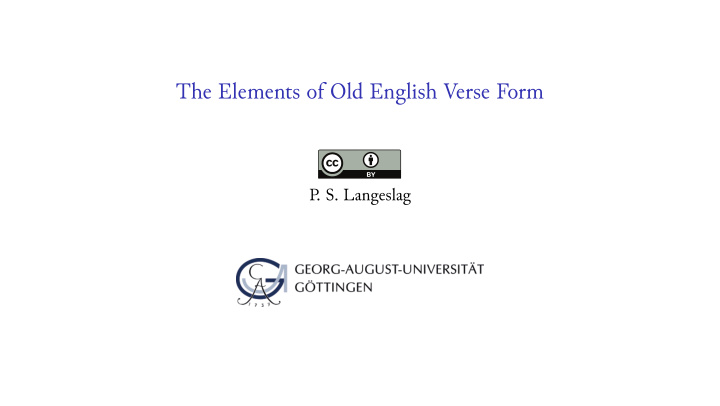



The Elements of Old English Verse Form P . S. Langeslag
Mē līfes onlāh se þis lēoht onwrāh, ond þæt torhte geteoh, tillīce onwrāh. Glæd wæs ic glīwum, glenged hīwum, blissa blēoum, blōstma hīwum. Riming Poem 1–4 Do Not Come Looking for These! ▶ End-rhyme (But The Riming Poem !) ▶ Stanzas (But Deor !) ▶ Refsains (But Deor !) ▶ Strict syllable counts ▶ The same foot contour throughout a poem
Do Not Come Looking for These! ▶ End-rhyme (But The Riming Poem !) ▶ Stanzas (But Deor !) ▶ Refsains (But Deor !) ▶ Strict syllable counts ▶ The same foot contour throughout a poem Mē līfes onlāh se þis lēoht onwrāh, ond þæt torhte geteoh, tillīce onwrāh. Glæd wæs ic glīwum, glenged hīwum, blissa blēoum, blōstma hīwum. Riming Poem 1–4
Syllable Structure syllable onset rhyme nucleus coda
By this defjnition, all of the following count as rhyme: End-rhyme The repetition at the end of two or more lines of the rhyme (i.e. nucleus and coda) of a stressed syllable along with any subsequent unstressed syllables Internal rhyme The repetition within a single line of the rhyme of a stressed syllable along with any subsequent unstressed syllables Slant rhyme Approximate repetition of the rhyme of a stressed syllable along with any subsequent unstressed syllables Assonance Repetition of the same vowel sound Paranomasia The use of similar-sounding words; includes slant rhyme and assonance Alliteration Repetition of the onset* of a stressed syllable * See Russom. What Is Rhyme? The exact or approximate repetition of sounds (for poetic efgect).
What Is Rhyme? The exact or approximate repetition of sounds (for poetic efgect). By this defjnition, all of the following count as rhyme: End-rhyme The repetition at the end of two or more lines of the rhyme (i.e. nucleus and coda) of a stressed syllable along with any subsequent unstressed syllables Internal rhyme The repetition within a single line of the rhyme of a stressed syllable along with any subsequent unstressed syllables Slant rhyme Approximate repetition of the rhyme of a stressed syllable along with any subsequent unstressed syllables Assonance Repetition of the same vowel sound Paranomasia The use of similar-sounding words; includes slant rhyme and assonance Alliteration Repetition of the onset* of a stressed syllable * See Russom.
Verse Form Figure 1: Oxford, Bodleian Library, MS Junius 11, p. 5 (detail); (c) Bodleian Library
Rhythm ▶ Two verses per long line (separated by a caesura) Ofu Scyld Scēfjng sceaþena þrēatum, ▶ Two feet per verse ▶ One full lifu per foot monegum mǣġþum meodosetla oftēah, ▶ Variable number of unstressed syllables eġsode eorlas, syððan ǣrest wearð per foot fēasceafu funden. Hē þæs fsōfse ġebād: wēox under wolcnum, weorðmyndum þāh, oðþæt him ǣġhwylċ þāra ymbsittendra ofer hronrāde hȳran scolde, gomban ġyldan. Þæt wæs gōd cyning. Beowulf 4–11
Alliteration ▶ One (usually the fjrst) or both lifus in the Ofu Sc yld Sc ēfjng sc eaþena þrēatum, sc-alliteration a-verse ▶ First lifu in the b-verse m onegum m ǣgþum m eodosetla oftēah, ▶ Never the second lifu e gsode eo rlas, syððan ǣ rest wearð vowel alliteration in the b-verse ▶ Vowels alliterate f ēasceafu f unden. Hē þæs f rōfse gebād: among themselves w ēox under w olcnum, w eorðmyndum þāh, ▶ sc , sp , st keep to oðþæt him ǣ ġhwylċ þāra y mbsittendra vowel alliteration themselves ofer h ronrāde h ȳran scolde, g omban ġ yldan. Þæt wæs g ōd cyning. Beowulf 4–11
Common Misconceptions About Alliteration in Old English Verse 1. It concerns the fjrst letter of a word. 2. Any two words that begin with the same sound alliterate. 3. It is normal and expected for it to extend over several lines.
Transverse Alliteration s ancte P etres p reostas s yþþan Seasons for Fasting 100 Linked Alliteration s inċ æt s ymle. S ele h līfade h ēah ond h ornġēap; h eaðowylma bād Beowulf 81–82 Special Kinds of Alliteration Crossed Alliteration swā se h alga w er h erġende w æs Azarias 49
Linked Alliteration s inċ æt s ymle. S ele h līfade h ēah ond h ornġēap; h eaðowylma bād Beowulf 81–82 Special Kinds of Alliteration Crossed Alliteration swā se h alga w er h erġende w æs Azarias 49 Transverse Alliteration s ancte P etres p reostas s yþþan Seasons for Fasting 100
Special Kinds of Alliteration Crossed Alliteration swā se h alga w er h erġende w æs Azarias 49 Transverse Alliteration s ancte P etres p reostas s yþþan Seasons for Fasting 100 Linked Alliteration s inċ æt s ymle. S ele h līfade h ēah ond h ornġēap; h eaðowylma bād Beowulf 81–82
Schema of the Old English Verse Line a-verse (on-verse) b-verse (ofg-verse) caesura lēodum līðost ond lofġeornost type A type C Beowulf 3182 1 2 3 lifus: 4 alliteration: 1 2 3
Not in the Manuscripts ▶ Verse layout ▶ Modern punctuation ▶ Modern capitalization ▶ Line numbers ▶ Modern emendations ▶ (Visible caesuras)
langeslag.uni-goettingen.de Bibliography Russom, Geofgrey. “General Principles of Poetic Form.” In The Evolution of Verse Structure in Old and Middle English Poetry: From the Earliest Alliterative Poems to Iambic Pentameter , by Geofgrey Russom, 1–34. Cambridge: Cambridge University Press, 2017. Scragg, Donald G. “The Nature of Old English Verse.” In The Cambridge Companion to Old English Verse , 2nd ed., 50–65. Cambridge: Cambridge University Press, 2013.
Recommend
More recommend